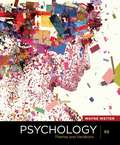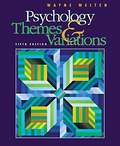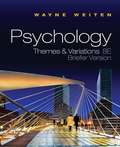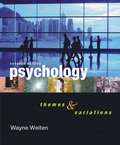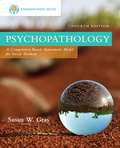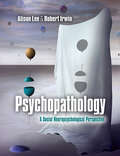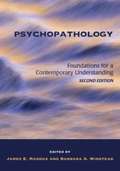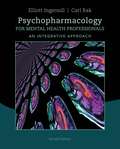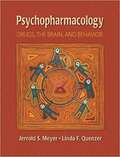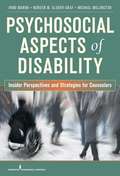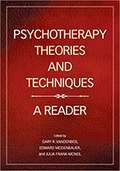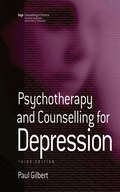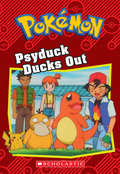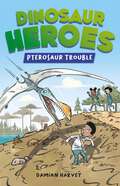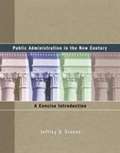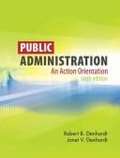- Table View
- List View
Psychology: Themes and Variations
by Wayne WeitenA more concise version of the introductory psychology text offering thorough coverage of the major theories (and controversies) in the field today. The focus is on ideas rather than facts, integrating research and application in the areas of biological behavior concepts, sensation and perception, consciousness, conditioning, memory, language and thought, intelligence and psychological testing, emotion, human development, personality theory, stress, psychological disorders, psychotherapy, and social behavior. Includes very jazzy color photographs and illustrations. Paper edition (unseen), $48. 75. Annotation c. by Book News, Inc. , Portland, Or.
Psychology: Themes and Variations
by Wayne WeitenBiological bases of behaviour - Sensation and perception - Sleep and dreams - Learning through conditioning - Human memory - Language and thought - Intelligence and testing - Motivation and emotion - Human development across the life span - Personality - Coping and stress management - Suicide - Psychological disorders - Psychotheraphy - Social behaviour - Split brain research (Gazzaniga, Bogen & Roger Sperry)
Psychology: Themes and Variations (5th Edition)
by Wayne WeitenFilled with exciting, current research findings, this affordable CENGAGE ADVANTAGE BOOKS version of PSYCHOLOGY: THEMES AND VARIATIONS shows you the many ways that psychology applies to your life today and every day! In the book's "Featured Studies," you'll get a bird's eye view of real psychological research in action. "Critical Thinking Applications" give you specific critical thinking tools that you can use to help you think analytically and critically about what you read. Weiten also helps you excel in the psychology course by including overarching concepts--weaving these concepts throughout the book to help you see how the topics and research you are studying fit together into one understandable picture called psychology! Every chapter offers tools to help you focus on what's important--showing you how to study in ways that help you retain information and do your very best on exams.
Psychology: Themes and Variations (8th Edition)
by Wayne WeitenIn PSYCHOLOGY: THEMES AND VARIATIONS, BRIEFER VERSION, Wayne Weiten continues his proven combination of a scientifically rigorous text with selective pedagogy that makes learning easy for students. Weiten's approach is backed by a straightforward writing style, unparalleled in-text visuals and didactic art program, and in-book review to help users prioritize and retain the core concepts. Weiten surveys psychology's broad range of content with three aims: to illuminate the process of research and its intrinsic relationship to application (themes); to show both the unity and diversity of the subject (variations), and to invite users to the study of psychology by respecting their ability to master its fundamental concepts. Weiten's themes (including empiricism, theoretical diversity, sociohistorical contexts, multifactorial causation, cultural heritage, heredity and environment, and subjectivity of experience) and variations provide unifying threads across chapters that help users see the connections among different research areas in psychology.
Psychology: Themes and Variations (Seventh Edition)
by Wayne WeitenThe Seventh Edition of Wayne Weiten's popular text, Psychology: Themes and Variations, continues to offer students a unique survey of psychology with three distinct goals: to show both the unity and diversity of psychology's subject matter; to illuminate the process of research and its intimate link to application, and to make the text challenging to think about and easy to learn from.
Psychopathology: A Competency-Based Assessment Model for Social Workers (Empowerment Series)
by Susan GrayWritten by a practicing social worker, PSYCHOPATHOLOGY offers a compelling look at the current state of knowledge about mental disorders. The authors' accessible narrative blends with detailed, realistic vignettes to give you an inside look at what it means to practice psychopathology today. Part of the Cengage Empowerment Series, the fourth edition is completely up to date and thoroughly integrates the new DSM-V. It also integrates the core competencies and recommended practice behaviors outlined in the 2008 Educational Policy and Accreditation Standards (EPAS) set by the Council on Social Work Education (CSWE).
Psychopathology: A Social Neuropsychological Perspective
by Robert Irwin Alison LeeIn Psychopathology: A Social Neuropsychological Perspective, Lee and Irwin demonstrate that mental distress often defies traditional forms of medical classification. Integrating both psychosocial and neuropsychological frameworks, they present a unique and balanced perspective on psychopathology, emphasising the importance of context, relationships and neuroplasticity. Written to support teaching and learning at the undergraduate level, Psychopathology: A Social Neuropsychological Perspective encourages students to explore alternatives to traditional diagnostic models. <P><P>Pedagogical features such as reflection points in each chapter encourage critical engagement and classroom debate. The result is an original examination of mental distress and a stand-alone resource for students in this area.<P> Questions the validity of the dominant diagnostic framework of psychopathology (grounded in the Diagnostic and Statistical Manual of Mental Disorders and the International Classification of Diseases)<P> Presents a variety of perspectives on mental distress, emphasising the importance of context, relationships and neuropsychological processes.<P> Encourages critical engagement through pedagogical features such as reflection points in each chapter, and provides a balanced discussion of issues from differing perspectives and authors, supporting classroom debate.<P> Fills a much-needed gap in the market for instructors who do not want to base their class on the DSM/ICD approach to abnormal psychology.
Psychopathology: Foundations for a Contemporary Understanding (2nd Edition)
by Barbara A. Winstead James E. MadduxPsychopathology is intended for first-year graduate students in clinical psychology, counseling psychology, and related fields, and it has been specifically designed to meet the needs of students in these courses. Maddux and Winstead have brought together the most distinguished researchers in the fields of clinical psychology and psychopathology in order to provide up-to-date information about theory and research, as well as to challenge students to think critically about psychopathology. Thoroughly revised and updated from the previous edition, the book focuses throughout on what has been demonstrated by research, not on what has been claimed by theories that may be accepted or traditional but lack empirical support. The first section presents and analyzes the basic concepts we need to understand any disorder; the second examines the disorders most frequently encountered in clinical practice.
Psychopharmacology for Mental Health Professionals: An Integrative Approach (2nd Edition)
by R. Elliott Ingersoll Carl F. RakThis book is an introductory level text on psycho-pharmacology for students preparing for careers in psychology, counselling, and social work.
Psychopharmacology: Drugs, The Brain, And Behavior
by Jerrold Meyer Linda QuenzerUnique in its breadth of coverage ranging from historical accounts of drug use to clinical and preclinical behavioral studies, Psychopharmacology is appropriate for undergraduates studying the relationships between the behavioral effects of psychoactive drugs and their mechanisms of action.
Psychopharmacology: Drugs, the Brain, and Behaviors (2nd Edition)
by Richard A. Harvey Michelle A. Clark Richard Finkel Jose A. Rey Karen WhalenRecent advances in molecular pharmacology and brain imaging have revolutionized our understanding of how psychoactive drugs work. Now, from the authors of Principles of Neuropsychopharmacology, comes a new undergraduate textbook integrating these developments. The first section of the book provides extensive foundation materials, including the basic principles of pharmacology, neurophysiology and neuroanatomy, synaptic transmission, and methods in psychopharmacology. The second section describes key features of major neurotransmitter systems, including the catecholamines, serotonin, acetylcholine, glutamate and GABA. The third and fourth sections discuss theories and mechanisms of drug addiction and psychopathology. All major substances of abuse as well as drugs used to treat mental illness are covered. Psychopharmacology: Drugs, the Brain and Behavior is unique in its breadth of coverage, ranging from historical accounts of drug use to clinical and preclinical behavioral studies to the latest research on drug effects in transgenic mouse models. Student engagement with the material is fostered by opening each chapter with a relevant vignette and by providing breakout boxes presenting novel or cutting-edge topics for special discussion. The book is extensively illustrated with full-color photographs and line art depicting important concepts and experimental data. Psychopharmacology: Drugs, the Brain and Behavior is appropriate for undergraduate psychopharmacology or drugs and behavior courses that emphasize relationships between the behavioral effects of psychoactive drugs and their mechanisms of action.
Psychosocial Aspects of Disability (Fourth Edition)
by George Henderson Willie V. BryanThis new edition of Psychosocial Aspects of Disability strikes a balance of past, present, and future views of individual, family, societal, and governmental interaction and reaction to persons with disabilities. The past is presented in Part 1, Psychosocial Aspects of Disabilities, in which a view of the evolution of societal reactions to disabilities and persons with disability is presented. This perspective is important because it explains how some of the beliefs and attitudes toward disabilities and those who have a disability have developed. Additionally, Part 1 makes us aware from a historical perspective why persons with disabilities have been subject to certain types of treatment from family, friends, and society. Parts 2 and 3 provide discussion of present situations for persons with disabilities as they move toward better inclusion in society. Chapter 5 discusses the need for empowerment of persons with disabilities and how they can empower themselves. Chapter 6 discusses the need for better employment opportunities for persons with disabilities because this is a significant way of empowering persons with disabilities. Chapter 7 discusses federal legislation that has been developed to facilitate the empowerment of persons with disabilities. Part 4, Psychosocial Issues, to a large extent, represents the future for persons with disabilities. The chapters in this section discuss some disability issues that some persons with disabilities will encounter and/or by which they will be affected during the twenty-first century. Additionally, there is discussion of the need for persons with disabilities to attain the full human rights to which they are entitled.
Psychosocial Aspects of Disability: Insider Perspectives and Counseling Strategies
by Irmo Marini Noreen M. Glover-Graf Michael Jay MillingtonWhat a marvelous and amazing textbook. Drs. Marini, Glover-Graf and Millington have done a remarkable job in the design of this highly unique book, that comprehensively and very thoughtfully addresses the psychosocial aspects of the disability experience. These highly respected scholars have produced a major work that will be a central text in rehabilitation education for years to come. From the Foreword by Michael J. Leahy, Ph. D. , LPC, CRC Office of Rehabilitation and Disability Studies Michigan State University This is an excellent book, but the best parts are the stories of the disabled, which give readers insights into their struggles and triumphs. " Score: 94, 4 Stars--Doody's Medical Reviews What are the differences between individuals with disabilities who flourish as opposed to those who never really adjust after a trauma? How are those born with a disability different from individuals who acquire one later in life? This is the first textbook about the psychosocial aspects of disability to provide students and practitioners of rehabilitation counseling with vivid insight into the experience of living with a disability. It features the first-person narratives of 16 people living with a variety of disabling conditions, which are integrated with sociological and societal perspectives toward disability, and strategies for counseling persons with disabilities. Using a minority model perspective to address disability, the book focuses on historical perspectives, cultural variants regarding disability, myths and misconceptions, the attitudes of special interest and occupational groups, the psychology of disability with a focus on positive psychology, and adjustments to disability by the individual and family. A wealth of counseling guidelines and useful strategies are geared specifically to individual disabilities. Key Features: Contains narratives of people living with blindness, hearing impairments, spinal cord injuries, muscular dystrophy, polio, mental illness, and other disabilities Provides counseling guidelines and strategies specifically geared toward specific disabilities, including "dos and don'ts" Includes psychological and sociological research relating to individual disabilities Discusses ongoing treatment issues and ethical dilemmas for rehabilitation counselors Presents thought-provoking discussion questions in each chapter Authored by prominent professor and researcher who became disabled as a young adult
Psychosocial Aspects of Disability: Insider Perspectives and Strategies for Counselors
by Irmo Marini Michael J. Millington Noreen M. GrafWhat are the differences between individuals with disabilities who flourish and those who never really adjust after a trauma? How do those born with a disability differ from individuals who acquire one later in life? <p><p>Fully updated and revised, this second edition of a unique rehabilitation counseling text reflects growing disparities among "haves" and "have-nots" as they bear on the psychosocial aspects of disability. New content focuses on returning veterans afflicted with physical and mental health problems, persons with disabilities living in poverty, and the need for increased family and community-based engagement. The book provides updated information about assisted suicide, genetic testing, new legislation, and much more. <p><p>Using a minority model perspective, the text provides students and practitioners of rehabilitation and mental health counseling with vivid insight into the experience of living with a disability. It features first-person narratives from people living with a variety of disabling conditions, which are integrated with sociological and societal perspectives toward disability, and strategies for counseling such individuals. The text encompasses a historical perspective, psychological and sociological research, cultural variants regarding disability, myths and misconceptions, the attitudes of special interest and occupational groups, the use of positive psychology, and adjustments to disability by the individual and family. A wealth of counseling guidelines and useful strategies is geared to individuals with specific disabilities. Designed for a 15-week semester, the book also includes thought-provoking discussion questions and exercises.
Psychotherapy Theories and Techniques: A Reader
by Gary R. VandenBos Edward Meidenbauer Julia Frank-McNeilPsychotherapy Theories and Techniques explores the richness and variety of psychotherapy in a collection of carefully chosen excerpts from APA publications. Intended for students and practitioners, this volume provides a unique look at contemporary psychotherapy theory and the specific interventions associated with each orientation. <p><p> All major approaches in psychotherapy are included—everything from cognitive–behavioral therapy to psychoanalytic therapy—as well as newer approaches such as acceptance and commitment therapy and schema therapy.
Psychotherapy and Counselling for Depression (Therapy in Practice)
by Paul Raymond Gilbert`Excellent! Excellent! Excellent! I would thoroughly recommend this book to any other counsellor of psychotherapist. It is described on the back cover as 'outstanding', 'valuable' and an 'essential resource' and I would fully endorse all of these descriptions. I have been qualified for 10 years and have had extensive client experience, but feel I have gained so much from Gilbert's wisdom on this topic. It is excellent value for money and again I would recommend it to any practitioner' - The Independent Practitioner 'This book takes the reader gently but thoroughly through the biopsychosocial processes that underpin depression. Excellent worksheets and information sheets are provided as appendices. [It] is a valuable resource for those who already work with depression and essential reading for those considering working in this field' - Therapy Today `Paul Gilbert provides the reader with a refreshingly wide-ranging, integrative and up-to-date understanding of the nature, assessment and treatment of depression. All psychological therapists will benefit from reading his important book' - Healthcare Counselling and Psychotherapy Journal `Paul Gilbert writes in a scholarly, yet accessible, style on the bio-psychosocial perspectives of depression. I agree with him that knowledge of such areas is crucial to being able to work effectively with people experiencing depression' - Nursing Standard, 5 star review `Psychotherapy and Counselling for Depression, Third Edition by the distinguished psychologist, Paul Gilbert, is an outstanding contribution to the field. I read this book with great enthusiasm and interest - and, I must acknowledge - admiration. All clinicians will benefit from reading this valuable book' - Robert L. Leahy, President, International Association for Cognitive Psychotherapy Paul Gilbert's Psychotherapy and Counselling for Depression, Third Edition is a popular and practical guide to working with people suffering from depression. The book is based on a wealth of research into evolutionary, cognitive, behavioural and emotion-focused approaches to depression. It outlines how to work with general negativity, sense of failure and abandonment, and feelings of powerlessness, anger, shame and guilt The book examines the essential stages of the therapeutic process from conceptualization and formulation through to a wide variety of interventions for different types of difficulty. It has been greatly revised, expanded and updated for the Third Edition and: o explores in depth the biopsychosocial processes underpinning depression o shows how a compassionate mind approach can be incorporated into different types of therapy o includes a new chapter focusing on the role of the therapeutic relationship, including therapeutic dialogues o features detailed guidance with case examples on how to work with a wide variety of depressions. Psychotherapy and Counselling for Depression, Third Edition is an essential resource and comprehensive guide for practitioners and anyone involved with treating depression. Paul Gilbert is Professor of Psychology in the Mental Health Research Unit at Kingsway Hospital, Derby.
Psycology EM Textbook for 2nd PUC Revised Edition 2023
by Department of Pre-University Education Malleshwaram BangaloreIt is an educational textbook for 2nd PUC English Medium students, based on the Psycology Textbook.
Psyduck Ducks Out (Pokémon Chapter Books)
by Jennifer Johnson S. E. HellerThis reissued illustrated chapter book is based on the classic characters found in Pokemon GO and the classic animated series on Netflix.When Psyduck evolves into Golduck, Misty is thrilled! Golduck is the fastest swimmer of all. Besides, training Psyduck was one big headache. Psyduck was totally clueless and clumsy, except when it got a headache. Then its attacks were unstoppable -- especially against Team Rocket! But is Golduck about to give Misty a big surprise? This chapter book is based on a thrilling storyline from the top-rated animated series now on Netflix. Black-and-white illustrations throughout.
Pterosaur Trouble (Dinosaur Heroes)
by Damian HarveyJoin our team of Heroes in this fast-paced, dinosaur-themed chapter bookIn Ptersaour Trouble the heroes investigate the theft of some pterosaur eggs which leads them to a shocking discovery ... and some very close encounters with dinosaurs!Great for readers age 7+ these Dinosaur Heroes adventure stories are also full of fascinating facts about dinosaurs.These black and white illustrated chapter books are perfect for bringing dinsoaur and science facts to young readers, inspiring a thirst for knowledge and learning by stealth. The team of characters each specialise in a unique STEM skill and come from around the world to give a truly global outlook, too.The books are also book banded at Band 12 Brown.
Public Administration in the New Century: A Concise Introduction
by Jeffrey D. GreenePUBLIC ADMINISTRATION IN THE NEW CENTURY: AN INTRODUCTION TO THE WORLD OF PUBLIC MANAGEMENT, is a concise guide for anyone working toward a career in this field! This concise yet informative text will provide you with a solid introduction to the fundamentals, as well as coverage of the history of the discipline, bureaucracy, organizational theory and behavior, public budgeting, personnel administration, public policy, and ethics.
Public Administration: A Case Study Approach
by Gerald GarveyThe text incorporates three kinds of study materials: original essays, texts drawn from the scholarly literature, and case studies. By interweaving these strands, students can gain a true appreciation of the profession of public administration while, at the same time, exercising the real-life skills of practitioners in the field.
Public Administration: An Action Orientation (Sixth Edition)
by Robert B. Denhardt Janet V. DenhardtAs its title implies, PUBLIC ADMINISTRATION: AN ACTION ORIENTATION, Sixth Edition, encourages students to become active participants in public administration. Robert B. Denhardt and Janet V. Denhardt instruct readers on how to influence the operations of public agencies--helping them learn to get involved and effect positive changes, regardless of whether they are working outside the agency as citizens or within the agency as managers. With a strong emphasis on ethics, PUBLIC ADMINISTRATION: AN ACTION ORIENTATION, Sixth Edition, introduces the theories and scholarly literature of the field. In addition, it increases students' chances of being effective by developing practical skills such as personal management, communication, delegation, motivation, and decision making. Important topics such as nonprofit management, the global dimensions of public administration, and organizational theory are covered thoroughly in this book.
Public Administration: Concepts and Cases (9th Edition)
by Richard J. Stillman IIThe book offers a unique and highly regarded framework in which conceptual readings are paired with contemporary case studies that reflect real-world examples of administrative work, as well as new thinking and developments in the field. Case studies and examples cover topics such as the Columbia space shuttle disaster, the shootings at Columbine High School, and the war in Iraq, making it easy to engage students in the readings.
Public Administration: Social Change and Adaptive Management
by N. Joseph Cayer David L. Baker Louis F. WeschlerA book of 7 chapters, this text moves from a general discussion of Public Administration to the American Political Context, to theories of organization and management styles. It discusses resource allocation, planning and budgetary systems, and concludes with suggestions for an adaptive approach, improving public administration education, and the new challenges ahead.
Public And Private Families: A Reader
by Andrew J. CherlinPublic and Private Families: A Reader, seventh edition, exemplifies Andrew Cherlin's belief that families matter in both the public and private sphere, and the book's 28 readings reflect this notion. Keyed to the fourteen chapters of Cherlin's successful text Public and Private Families: An Introduction, also in its seventh edition, the reader includes both veteran and updated materials that both supplement and enhance the introduction.

